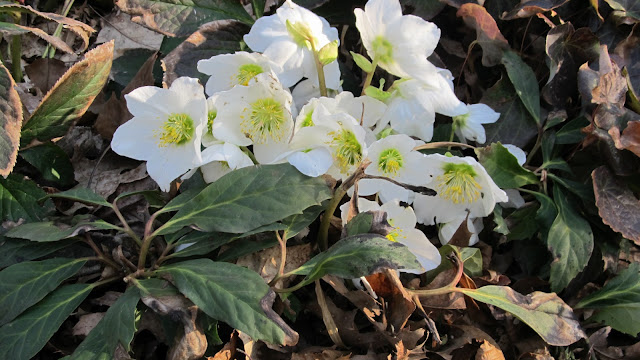Hellebore - Helleborus Niger - Christmas Rose - Elleboro
and friends and relations
 |
| Christmas rose |
Many years ago, walking in the hills above Griante, Lake Como, towards a small church with a view, San Martino, we happened upon an unforgettable scene: dozens and dozens of white hellebore growing in a dappled forest. They were so perfect, so abundant and thriving, it was a marvel. The sight is probably not mentioned in the guides because our walk took place at the end of winter, an unusual time for a hike in the hills. I now know that the hellebore were the well-loved Helleborus niger.
The middle to end of winter is when hellebore appears in the woods: first the dark green pointy leaves bursting up from the ground in a bush, then the ranuncula-like open-faced flowers which are white in this case, although many varieties and hybrids are cultivated nowadays and along with the glorious Amaryllis lily, seem to be the flower of the decade.
 |
| from white to darkest purple |
At Le Ripe we are lucky to have two varieties, though not the niger. Spread around our lime-rich woods in pleasing clusters, is the less appealing but still striking Helleborus foetidus, otherwise known as bearsfoot, dungwort and stinking hellebore, which has green, cup-like, drooping blooms edged with purplish red. It turns out not to be stinking at all. Research for this post has led to the satisfying discovery that this native, abundant 'stinking hellebore' is graced with the 'award of garden merit' by the Royal Horticultural Society. So there.
 |
| our very own foetidus - such a shame, the name! |
 |
| Helleborus foetidus |
The other variety at Le Ripe, found only at a certain altitude (roughly 340-350m above sea level) and in a certain area of the woods, is the prettier helleborus viridis or perhaps occidentalis (neither is supposed to be growing this far south, but there you are...), otherwise known as green hellebore. It is a much smaller plant and not ebullient like its cousin; this little beauty is shy and retiring.
 |
| our 'wandering' helleborus viridis or occidentalis |
Most hellebore are toxic, which is doubtless why the deer don't touch them.
Interesting stories about their medicinal use and abuse abound, but instead of quoting them in full and getting the credit for someone else's hard work, let me guide you to an interesting site, The Poison Garden, which discusses these aspects thoroughly. Meanwhile we shall enjoy our displays, large and small, of this beautiful and unusual native winter bloom.
 |
| captured this morning |

Lovely, lovely piece!
ReplyDeleteWhy thank-you, Agricola!
ReplyDeletestunning pictures, some look professional...
ReplyDeleteI see these all the time but finally I know so much,
will look with different eyes!
What is the etymology of Helleborus, since some of the layperson names are interesting?
Thank-you but two or three of the photos may be professional since I swiped them from internet...but the single blooms and the close-up foetidus are mine. Etymology of hellebore from online dictionary:
ReplyDeletehellebore (n.)
late 14c., from Old French ellebore, from Latin elleborus, from Greek helleboros, perhaps meaning "plant eaten by fawns," from Greek ellos/hellos "fawn" + bora "food of beasts," from bibroskein "to eat," from PIE root *gwere- "to swallow." Among the ancients, the name given to various plants of both poisonous and medicinal qualities, reputed to cure madness.
Thanks for asking, it was worth it!
On a Reddit forum called "whatsthisplant" I posted a photo of a flower I came across and someone ID'd it as Helleborus. So I googled "helleborus lake como" because that's where I saw the flower, and I found your post (only then learning the exact species). And in fact, it was on that same hike up to San Martino that my wife and I saw the flowers, in little clumps, leaning towards the sun, wondering what they were! We are transplants from New York City who live now in Nobiallo, the little fishing village just north of Menaggio, here about a year and a half now. We have visited the Tuscan countryside only a couple times very briefly, though my wife lived in Florence for several months years ago... Le Ripe certainly looks lovely! Cheers!
ReplyDelete